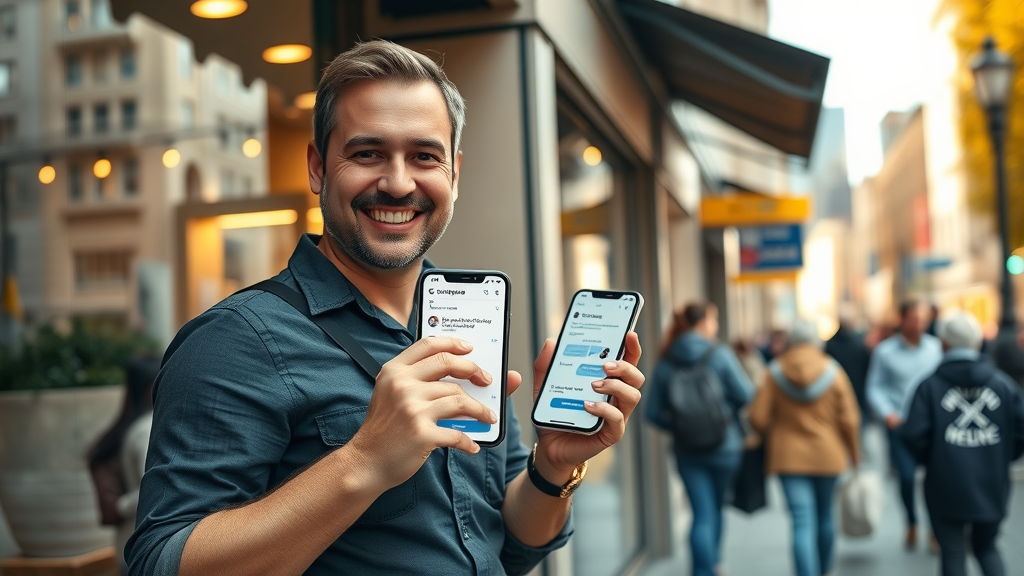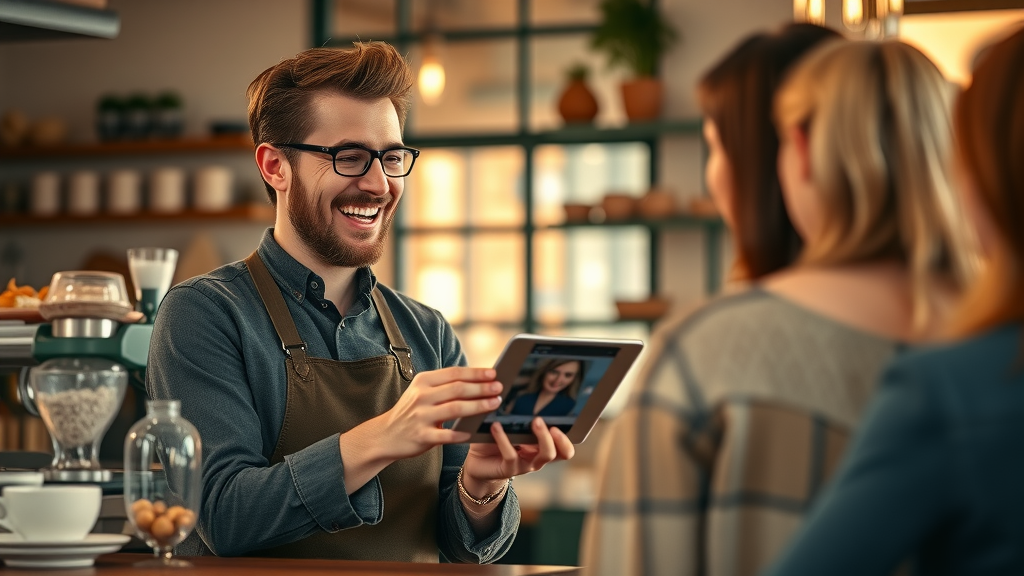"Over 71% of small businesses report gaining new customers through social media marketing—proving its necessity rather than luxury in the modern marketplace."
What You’ll Learn in This Guide
- Instant growth hacks to elevate your social media presence.
- How to choose the best media platforms for your small business.
- Sharpening your brand voice and building authentic connections.
- Content creation tools and automation for small business efficiency.
- Analytics and performance measurement to track true ROI.
- Strategies for harnessing trends and user-generated content to skyrocket growth.
Unleashing the Power of Social Media Marketing for Small Businesses
Today, social media marketing for small businesses is the driving force behind rapid growth and brand awareness in crowded marketplaces. With billions of media users worldwide, leveraging social media platforms like Facebook, Instagram, LinkedIn, and TikTok is not just advantageous—it's absolutely essential for any small business owner seeking a competitive edge. By establishing a robust social media presence, small businesses can connect directly with potential customers, showcase unique offerings, and build lasting relationships that translate into sales and loyalty.
The power of these media platforms lies in their ability to level the playing field, allowing even the smallest local retailer to compete with larger brands through creative content, targeted ads, and community engagement. In an age where social proof sways decisions, being visible and active on key social media channels helps to instill credibility, attract attention, and nurture meaningful audience interactions. For many small business owners , the journey from obscurity to mainstream recognition now begins and thrives on their chosen social media platform.

Why Social Media Presence is Essential for Small Businesses
A dynamic social media presence is the modern storefront for small businesses. With so many potential customers searching products and services online, your activity—or lack thereof—on social media platforms often serves as the first impression. It’s about more than just posting updates; your social media channels act as a direct line to consumers, opening opportunities to provide customer service, tell your brand’s story, and gather feedback in real-time.
Studies show that consumers are more likely to trust and support businesses they see actively engaged on platforms like Instagram and Facebook. Being present consistently doesn’t just build brand awareness, it also enhances your company’s reputation, attracts testimonials, and stimulates word-of-mouth marketing. Importantly, a robust social media presence allows small business owners to reach a wider audience beyond local zip codes, tapping into niche markets and connecting globally—all on a budget that works for even the leanest startups.

Growth Hacks: Actionable Social Media Marketing Strategies for Small Businesses
Identify the Right Social Media Platforms for Your Target Audience
Not all social media platforms serve the same audience or business goals. Successful social media marketing for small businesses starts by understanding where your target audience spends its time. For visual products, Instagram or Pinterest may be your best stage. If your services are B2B, LinkedIn could yield greater returns, while TikTok is perfect for brands targeting a youthful, trend-driven demographic.
Conduct basic market research to analyze competitor activities and user engagement on each platform. Consider not just the platform’s popularity, but its alignment with your business identity and customer preferences. Remember, quality over quantity counts—master one or two platforms to maximize your brand awareness, rather than diluting effort across every available channel. Engaging your audience directly requires knowing where they are, how they interact, and what content resonates with them most.
As you refine your approach to choosing the right platforms and crafting your content, it can be helpful to explore additional social media marketing tactics tailored for small businesses that address both strategy and day-to-day execution. These insights can further strengthen your ability to connect with your ideal audience and drive measurable results.
Timing and Consistency: Building a Strong Media Presence
Achieving lasting impact in media marketing requires both strategic timing and unwavering consistency. Algorithms on social media platforms favor accounts that post regularly, keeping followers engaged and algorithms boosting your content to new eyes. Tools like Buffer, Hootsuite, or Later enable you to schedule posts and maintain an active presence without constantly being online.
Analyze when your audience is most active—many platforms offer detailed analytics indicating peak engagement hours. By aligning your schedule with these windows, you improve post visibility and audience responses. Consistency also breeds trust; a business that posts frequently and reliably demonstrates professionalism and attentiveness, essential traits for nurturing potential customers through the buyer’s journey.

Paid vs. Organic Media Marketing: Which Works Best for Small Businesses?
Paid media marketing —including Facebook Ads, sponsored Instagram posts, and promoted tweets—offers fast-track visibility but incurs costs that add up. It’s a fantastic way to target specific demographics with laser precision, build quick brand awareness , and promote products or services during important campaigns. However, organic reach, built through engaging content, community conversations, and authentic storytelling, fosters deeper customer relationships over time.
For most small businesses , a hybrid approach is best. Start by developing a solid organic base: share behind-the-scenes stories, customer testimonials, and valuable tips in posts and Stories. Then, supplement with paid ads to reach new audiences beyond your immediate followers. Carefully monitor which strategies drive ROI with analytics tools to ensure your budget is being used effectively on the right mix of paid and organic media.
Crafting an Effective Media Marketing Strategy for Small Business Owners
Define Your Target Audience and Set Clear Objectives
The hallmark of any successful media marketing strategy is clarity: who are you targeting and what do you intend to achieve? Start by creating detailed profiles of your target audience —demographics, interests, media usage habits, and pain points. Leverage tools like Facebook Audience Insights or Google Analytics to gather real data. This focus ensures you craft relevant media content that genuinely appeals to your potential customers and inspires engagement.
Once your audience is defined, establish clear objectives for your social media campaigns. Are you looking to boost website traffic, grow an email list, or increase direct sales? Each goal shapes the type of content you produce, the platforms you prioritize, and the resources you’ll allocate. With objectives in place, setting measurable KPIs becomes straightforward and your path to success far easier to chart.

Build Your Unique Brand Voice and Media Content Plan
Your brand’s voice is your digital handshake—distinct, recognizable, and authentic. For small businesses , this can be a competitive advantage: leverage your story, values, and personality to connect with consumers on a human level. Develop a clear brand voice (friendly, witty, professional, etc.) and ensure it shines through every post, comment, and video.
Building a media content plan ensures that every piece of content serves your overarching strategy. Map out monthly themes, campaign goals, and a mix of content types (educational posts, product spotlights, behind-the-scenes, user stories, live streams). A defined plan prevents last-minute scrambling and ensures your social media feeds remain fresh, on-brand, and valuable to your audience.
Monitor Results: Analytics and Key Performance Metrics
No media marketing strategy is complete without robust measurement. Modern platforms provide built-in analytics that display post reach, engagement rates, follower growth, and click-through rates. Tracking these KPI metrics allows you to see what resonates and what falls flat, refining your content and timing for peak performance.
Use analytics dashboards from Facebook, Instagram, LinkedIn, or third-party tools like Sprout Social and SocialBee to create performance reports. Evaluate which media channels are delivering the best ROI, which content drives conversions, and where your most engaged audiences reside. Make analytics a weekly habit to spot trends, double down on successes, and continually optimize your campaigns.
Quick Overview: Social Media Marketing for Small Businesses Explained
Building Social Media Content That Engages and Converts for Small Businesses
Storytelling and Authenticity in Media Content
Audiences crave authenticity. Telling real stories—whether it’s your journey as a small business owner , customer testimonials, or behind-the-scenes peeks—helps forge a genuine connection. When you share your triumphs, challenges, or day-to-day moments, people relate, trust builds, and loyalty follows. This is the difference between simply broadcasting ads versus crafting an engaging social media presence.
To maximize impact, integrate your brand’s values and personality into every story. Celebrate milestones, spotlight employees, or share community involvement to humanize your business. Authenticity stands out as social media users grow ever more savvy, and it’s often the x-factor that converts followers into lifelong customers.

Content Creation Tools and Automation for Small Business Efficiency
Efficiency is key for small business owners juggling multiple responsibilities. Thankfully, modern content creation tools make it easier than ever to design eye-catching posts, even with limited time or experience. Canva and Adobe Express offer easy templates for quick graphics, while mobile apps help edit videos or schedule Stories for Instagram and Facebook.
Automation platforms like Hootsuite or Buffer are essential marketing tools , letting you batch-create content and schedule posts across multiple media channels . This ensures your audience receives consistent updates while freeing you up to focus on serving customers and enhancing products or services. These tools are particularly useful for maintaining an always-on media presence — the mark of a truly professional small business.

Leveraging User-Generated Content to Boost Media Presence
User-generated content (UGC) is one of the most powerful growth hacks available. Encourage satisfied customers to share photos, testimonials, or reviews of your products on their own profiles and tag your business. Not only does this foster community and trust, but it also boosts your credibility—and provides you with a stream of authentic content you can repurpose.
Highlight UGC by sharing customer success stories in your feeds and Stories, or by running contests that incentivize sharing your brand online. This not only increases brand awareness, but also creates a ripple effect as friends and followers of your existing customers are exposed to your business, effectively transforming loyal customers into micro-influencers.
Comparison of Major Social Media Platforms for Small Businesses
| Platform | Key Audience | Major Features | Ad Costs | Growth Potential |
|---|---|---|---|---|
| Adults 25-54, local and global | Groups, Facebook Ads, Visual & Text Posts, Messenger | Low to Moderate | High | |
| Young adults 18-34, lifestyle & retail | Stories, Shopping, Video Reels, Influencers | Medium | High | |
| B2B professionals, 25-45 | Networking, Articles, Sponsored Content, Recruitment | High | Moderate | |
| TikTok | Gen Z, 16-24 | Short Videos, Trending Challenges, Discovery | Low | Very High |
| 25-44, mainly female, DIY & retail | Pins, Boards, Rich Pins, Shopping | Low | Moderate |
Target Audience Insights: Customizing Social Media for Small Businesses
Performing Market Research for Your Media Marketing Strategy
Smart social media marketing for small businesses begins with in-depth research. Use surveys, polls, and insights from platforms like Facebook and Instagram to understand what your audience likes, shares, and comments on. Look at competitors’ successful posts and monitor trending topics in your niche to stay ahead of shifts in consumer interest.
Don’t underestimate the value of feedback directly from your own followers. Ask questions, host live Q&As, and monitor the responses to tweak your media marketing strategy . Regular research ensures your social media presence aligns with evolving audience preferences, maximizing engagement and conversions over the long term.

Segmenting Content for Multiple Audience Profiles
As your business scales, you may notice distinctive subgroups within your audience. Segmenting content allows you to address the unique needs and interests of each group. For example, a retailer might tailor posts for bargain-seeking shoppers, style-conscious buyers, and local community supporters.
Use platform analytics and A/B testing to see what content performs best for each segment. Try creating separate ad sets, targeted Stories, or exclusive group offerings to maximize engagement. Segmentation ensures every potential customer feels seen and valued, strengthening your overall social media marketing efforts for small businesses.
Advanced Instant Growth Hacks in Social Media Marketing for Small Businesses
Using Facebook Ads and Influencer Partnerships
Running a targeted Facebook ad campaign can provide instant visibility and quick conversions for small businesses. Facebook’s audience targeting lets you zero in on precise age ranges, locations, and interests, making every advertising dollar count. Combine this with retargeting strategies, where ads follow potential customers after visiting your website, to increase the likelihood of conversion.
Influencer partnerships—whether with local personalities or niche bloggers—can also unlock exponential growth. By aligning with individuals your audience already trusts, your brand awareness can spread faster and more authentically than conventional ads alone. Negotiate micro-influencer collaborations for product reviews, live demonstrations, or social contests to extend your reach and credibility on leading media platforms.

Utilizing Trends and Viral Challenges on Social Media Platforms
Social media thrives on the momentum of trends and viral content. By quickly adopting platform challenges, memes, and popular sounds, small businesses can tap into an enormous surge of visibility. TikTok dances, Instagram Hashtag Challenges, or participating in Twitter Trends lets you ride the wave of trending topics, rapidly boosting your profile and attracting large audiences.
To succeed, keep your content on-brand and relevant to your target audience. Don’t jump on every trend; instead, select those that fit your values, products, or services. Engaging with trends in a genuine way helps position your business as approachable, relatable, and timely—a winning combination for social media users seeking brands that speak their language.

Optimizing Your Social Media Profiles for Search and Conversion
A well-optimized profile can turn a curious browser into a loyal customer. Fill out every bio section with keywords relevant to your business and industry, making it easy for people to find you in searches. Use strong profile images, branded visuals, and pinned Stories or highlights to immediately communicate your value proposition.
Add calls-to-action (CTAs), such as “Shop Now”, “Book Appointment”, or “Send Message”, to every profile and post. Make sure your contact information, business hours, and website links are always up to date. An optimized profile isn’t just about visibility; it maximizes conversion potential, turning your media presence into measurable business results.
Step-by-Step Tutorial: Creating Your First Social Media Ad for Small Businesses
Lists of Must-Have Tools: Elevating Media Marketing for Small Businesses
- Best scheduling platforms: Buffer, Hootsuite, Later
- Top content creation tools: Canva, Adobe Express
- Leading analytics and automation: Sprout Social, SocialBee
Free and Paid Media Content Resources for Small Business Owners
There is a wealth of both free and paid resources for content creation and media management. Free tools like Canva, Unsplash, and Google Trends offer templates, stock images, and trending data that can add polish and strategy to your posts. Invest in paid premium versions of these platforms, or expand to tools like Adobe Express and Shutterstock for advanced design features and exclusive content.
For automation and analytics, most scheduling platforms offer free tiers but unlock advanced reporting and bulk scheduling with paid plans. Small businesses should start with the essentials and upgrade as the return on investment grows. Leveraging these resources saves time, ensures professional quality, and keeps your social media operation scalable as you grow.
How Small Business Owners Can Monetize Their Media Presence and Audience
Key Performance Indicators to Measure Social Media Success for Small Businesses
| Metric | What It Measures | Why It Matters |
|---|---|---|
| Engagement Rate | Likes, comments, shares, saves | Shows content resonates and builds community |
| Reach | Unique users who saw your post | Indicates market penetration and brand visibility |
| Growth Rate | Increase in followers over time | Measures organic or campaign-driven expansion |
| Click-Through Rate (CTR) | Clicks on links in posts/ad | Tracks content effectiveness and funnel progress |
| Conversion Rate | Actions (purchases, sign-ups) from social efforts | Calculates the direct impact on business goals |
Expert Insights: Quotes from Small Business Owners Succeeding with Social Media Marketing
"Embracing a creative media marketing strategy helped us double our customer base within six months." — Local Bakery Owner
Real-World Success Stories: Small Businesses Thriving via Media Marketing Strategies
- Local retailer who boosted sales 200% after focused Facebook campaigns
- Consultant who grew an email list with LinkedIn content
- Cafe that used Instagram Stories for pre-order engagement
People Also Ask: Social Media Marketing for Small Businesses
What is the 5 5 5 rule on social media?
The 5 5 5 rule for social media suggests engaging with five new people, replying to five conversations, and sharing five pieces of valuable content every day. This approach helps small businesses increase engagement, broaden their network, and keep their media presence consistently active—all critical factors for effective social media marketing.
What is the 50 30 20 rule for social media?
The 50 30 20 rule guides your content mix: 50% valuable and informative content, 30% shared from others or partnerships, and 20% self-promotional posts. This balance ensures your social media feeds provide value, foster community, and still promote your products and services —essential for building a thriving media presence .

What are the best social media marketing strategies for small businesses?
The most effective strategies include identifying the right platforms for your target audience , posting consistently, creating authentic and engaging content, leveraging user-generated material, and actively engaging with your followers. Paid ads and influencer marketing complement these efforts, especially when supported by solid analytics and ongoing adjustments to your media marketing strategy.
What is the 30 60 10 rule for social media?
The 30 60 10 rule refers to a balance of posts: 30% owned content (your original posts), 60% curated content (from others in your industry), and 10% promotional content. This mix provides value, builds authority, and encourages engagement while ensuring you don’t overwhelm your audience with sales messages.
Frequently Asked Questions on Social Media Marketing for Small Businesses
- How often should a small business post on social media platforms?
Posting at least three to five times per week is recommended to maintain a visible and active media presence , but your schedule should match your audience's engagement patterns and resources.
- Which social media marketing tool is best for automation?
Hootsuite, Buffer, and Later are among the top automation tools, allowing small businesses to schedule posts, manage multiple channels, and analyze performance with ease.
- Can media marketing work for service-based small businesses?
Absolutely! Service-based businesses can showcase expertise through tips, testimonials, and case studies, using platforms like LinkedIn or Facebook to reach potential clients and build trust.
- How do I track ROI on my social media campaigns?
Track ROI by measuring clicks, conversions, and direct sales from your social media efforts using analytics dashboards and UTM links tied to your marketing campaigns.
- What budget should a small business allocate for social media advertising?
Budgets vary, but even $100–$500 per month can generate results through targeted advertising. Test and scale your ad spend according to the channels and content that deliver the best performance.
Best Practices and Key Takeaways for Social Media Marketing for Small Businesses
- Consistency is crucial in media marketing for long-term success.
- Understand and focus your efforts on the social media platforms your audience uses.
- Quality, authentic media content builds trust and engagement.
- Use analytics to adapt social media presence and refine marketing strategy.
Summary and Next Steps to Supercharge Your Social Media Marketing for Small Businesses
Adopt these growth strategies, focus on your audience, and constantly optimize your social media marketing for small businesses . Build authentic connections, experiment with content, measure results, and watch your media presence and sales soar—no matter your industry or starting point.

Ready to Grow Faster?
Take control of your business’s future with a custom strategy. Schedule a Free Strategy Session Today!
Social media marketing is just one piece of the digital growth puzzle for small businesses. If you’re ready to expand your knowledge and discover how a comprehensive approach can amplify your results, explore our in-depth guide on building a powerful social media marketing strategy . This resource dives deeper into platform selection, campaign planning, and advanced engagement techniques—empowering you to take your business to the next level. Unlock new opportunities and set your brand apart by mastering the full spectrum of social media marketing.
To enhance your understanding of social media marketing for small businesses, consider exploring the following resources:
- “Guide: Social Media Marketing for Small Businesses” ( venngage.com )
This guide offers comprehensive strategies tailored for small businesses, including tips on branding, audience engagement, and content planning.
- “5 Social Media Tips Every Small Business Needs [+ Free Tools]” ( blog.hubspot.com )
This article provides actionable advice and free tools to help small businesses effectively navigate social media platforms.
These resources offer valuable insights and practical tips to help you develop and refine your social media marketing strategies, ensuring your small business thrives in the digital landscape.
 Add Row
Add Row  Add
Add 




Write A Comment